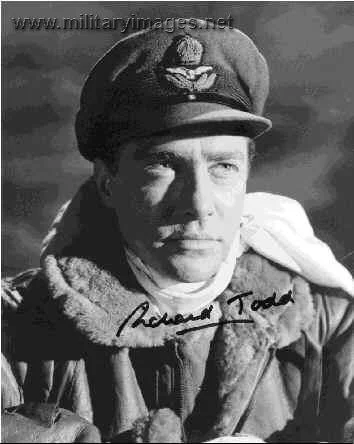- Extended Description
- It's sixty years since the liberation of France on
D-Day. Today it's a distant memory, but for the men who fought on the beaches and in the skies, it could be yesterday.
D-day was an important turning point in the Second World War. It's been immortalised in numerous movies including
D-day - The 6th June'.
The film's star, Richard Todd, recently returned to the battlefields of Normandy in France. It proved to be a very special trip, and one which brought memories of fifty years ago flooding back.
Real life action hero
Richard Todd is best known as a Hollywood legend, famous for roles in films such as 'The Dambusters' and 'The Longest Day'
Less well known is that Todd was a war hero. He was first out of the plane on D-day serving with the 6th Airborne.
Eighteen years later he relived the event in the film 'The Longest Day' with celluloid action hero John Wayne.
Todd trained for a military career as a young man at Sandhurst. This led to six years active service during the Second World War.
After the war, Richard Todd became one of Britain's best known actors.
Today he lives in Grantham where he recently found his war-time parachute in his attic. The discovery brought back a stream of wartime memories from over 50 years ago.
On the beach
June 6 1944 is a date that will remain etched in the memories of Richard Todd and the veterans who fought on Normandy's beaches.
One of the main strategic landmarks in the invasion was Pegasus Bridge. The bridge was captured in the first few moments of D-day by the 6th Airborne division in what's been described "as the finest piece of airmanship of the war".
The 6th Airborne was given the job of securing the easterly landing areas of the Normandy beaches. The plan was to pave the way for the rest of the Allied troops by opening up communication routes.
Amongst their key tasks were the capture of the German battery at Merville, and the seizure intact of the two bridges at Benouville.
Gliding in
Gliders played a vital part in the capture of the landings with pilots from the Glider Pilots Regiment playing a key role.
A special force of six gliders were sent in, carrying 180 men in total. The gliders were released from their tug aircraft at 5,000 feet in complete darkness, using only maps and stop watches.
Half of the gliders were to take the river bridge whilst the remainder of the pilots would take the canal bridge.
The first glider carrying Major John Howard and his men landed within yards of the canal bridge, making them the first Allied troops on French soil.
The men were temporarily knocked unconscious by the impact of the landing. Minutes later, they had abandoned their glider, and attacked a group of about 50 German soldiers who were taken by surprise.
The speed and surprise of the attack enabled the two bridges to be secured and held till the rest of the 6th Airborne arrived. The road link was now ready for the bulk of the invading Allied troops.
It was a remarkable achievement of courage and bravery against the odds.
The planning and execution of the landings had been impeccable.











